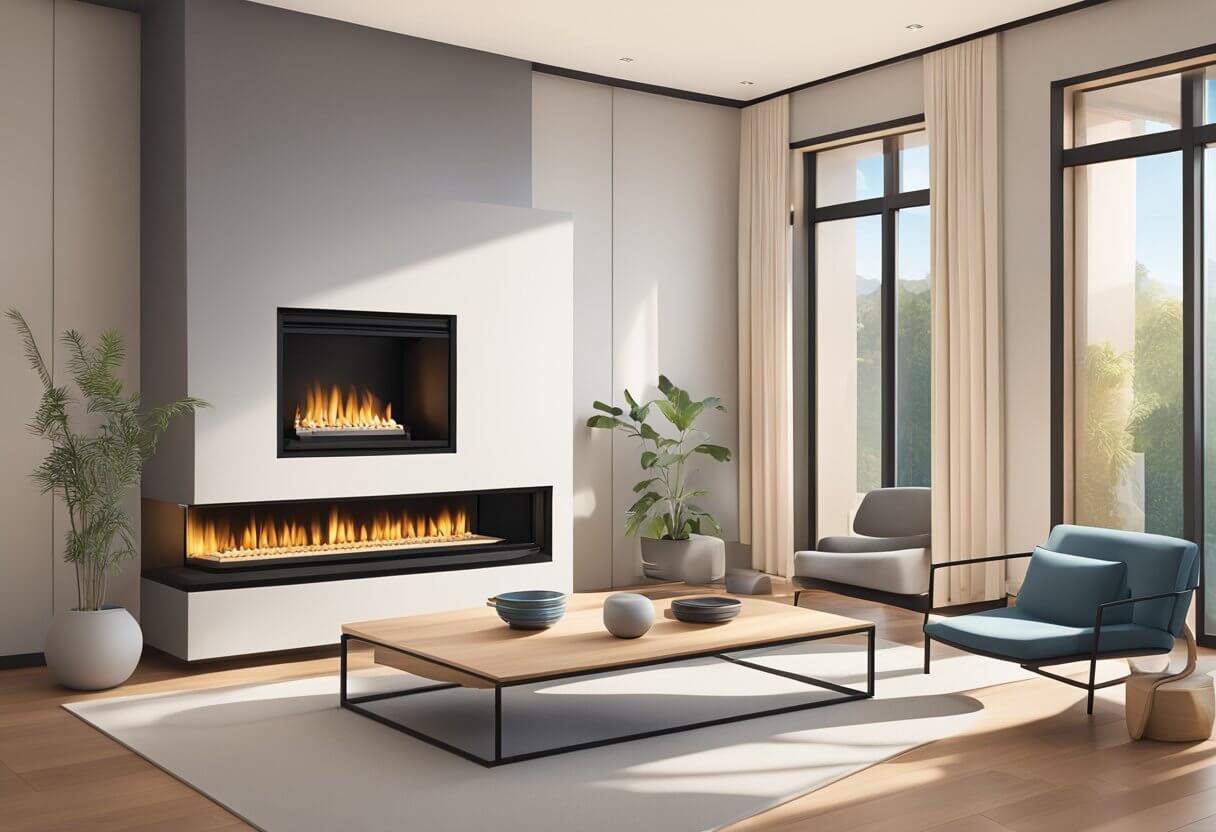Introduction
Chimneyless gas fireplaces represent a significant advancement in home heating technology, combining the warmth and ambiance of a traditional fireplace with modern convenience and design. Without the need for a chimney or flue, these innovative fireplaces offer homeowners more flexibility in installation and a cleaner burn. They are a compelling solution for those looking to integrate a fireplace into a home without an existing chimney structure or for apartment dwellers seeking the cozy appeal of a fire without structural modifications.
Their evolution has been marked by an increased focus on safety, energy efficiency, and aesthetic versatility. Today’s chimneyless gas fireplaces are designed with the latest safety features and adhere to strict installation regulations. In terms of efficiency, they often operate at a lower cost and with a smaller environmental footprint than their traditional counterparts. The design of these fireplaces has also expanded to fit a multitude of interiors, whether one desires a minimalist look or something that replicates the feel of a classic wood-burning hearth.
Key Takeaways
- Chimneyless gas fireplaces offer flexibility and a clean burn without the need for traditional chimney structures.
- They comply with stringent safety standards and are designed with energy efficiency in mind.
- The design options for chimneyless gas fireplaces have evolved to cater to a wide range of aesthetic preferences.
Installation and Regulations
When considering the addition of a chimneyless gas fireplace to one’s home, it is crucial to understand both the setup process and the relevant regulations that apply. Proper installation ensures efficient operation and compliance with safety standards is essential for legal and insurance purposes.
Setting Up Your Chimneyless Fireplace
Installation should begin with selecting the appropriate type of chimneyless fireplace for your space. Flueless gas fires are a popular choice for their ease of install; they don’t require a chimney or flue and simply need a gas connection and an adequate ventilation system to safely operate. Balanced flue gas fires and powerflue gas fires, on the other hand, require an external wall. They operate with a flue that pulls in air from outside and expels emissions through a dual-wall pipe or a roof vent, respectively.
One must work with a certified fireplace installer to ensure correct placement and connection to gas lines. The installer will also determine if any additional room ventilation is necessary. Installation includes a few key steps:
- Consultation: A professional assesses the space to advise on the most suitable fireplace model.
- Safety Inspection: Inspection of gas lines and ventilation adequacy.
- Placement: Strategic positioning for optimal heat distribution and aesthetic value.
- Connection: Hooking up the fireplace to the gas supply and to the existing power source if required.
- Testing: Checking for leaks and proper functionality.
Navigating Zoning and Safety Standards
Regulations governing the installation of chimneyless gas fireplaces vary by location. It is important to research local zoning laws to determine if specific requirements or prohibitions exist regarding types of fireplaces and fuel used. For example, some areas have restrictions on vent-free units due to concerns over indoor air quality.
In addition to zoning, national safety standards apply, such as those outlined by the National Fire Protection Association (NFPA). These standards are designed to protect homeowners from potential fire hazards and carbon monoxide poisoning. Compliance with these standards is non-negotiable and typically includes specific requirements regarding:
- Clearance: Ensuring that there are safe distances between the fireplace and flammable materials.
- Ventilation: Assessing that there is adequate airflow to prevent the buildup of harmful gases.
- Fuel: Using the correct type and quality of gas to maintain safe operation.
Adherence to these regulations is paramount, as failure to do so can result in fines, invalidated insurance, and safety risks. Homeowners are advised to engage with authorities and qualified professionals to navigate this process effectively.
Design and Aesthetic Considerations
Chimneyless gas fireplaces offer a contemporary twist on the warmth and ambiance of traditional heating solutions. Their design versatility enables them to blend with various interior themes, from minimalist to eclectic.
Incorporating Chimneyless Fireplaces into Decor
The seamless integration of chimneyless fireplaces within a home’s decor hinges on identifying the right aesthetic balance. A fireplace serves as a visual focal point, so the incorporation of textures and finishes that reflect the room’s design is essential. For homes aiming to maintain a traditional look, units with real flame effects and classic detailing can evoke the charm of a classic hearth. Materials like wrought iron or brass can add an element of traditional design, ensuring the modern appliance pays homage to the time-honored comfort of fireplace warmth.
In contrast, for more modern interiors, chimneyless fireplaces can be sleek, featuring clean lines and reflective surfaces like glass or polished metal that complement a contemporary palette. The lack of a chimney permits more freedom in placement, thus interior designers often recommend treating these units as art; placing them in a central location or integrating them into custom-built elements that serve as the room’s centerpiece.
Choosing the Right Model for Your Space
Selecting the appropriate model is pivotal for both functionality and aesthetics. Consideration should extend beyond just the fireplace unit to the spatial constraints and ambiance goals of the intended room. For larger spaces, a substantial freestanding fireplace can make a strong statement and become a source of radiant heat, while for smaller or more intimate settings, a compact wall-mounted unit can provide the necessary warmth without overwhelming the space.
Chimneyless gas fireplaces are available in a variety of sizes and BTU outputs, accommodating diverse space requirements from expansive living rooms to cozy reading nooks. In terms of design, one should examine the textures present within the space and seek out a fireplace texture that either seamlessly blends with or thoughtfully contrasts the existing decor. Models featuring real flame technology can enrich the experience by emitting a lifelike fire appearance, augmenting both the visual and tactile appeal of a room.
When implemented thoughtfully, chimneyless gas fireplaces are not only efficient heating sources but also vital design elements that contribute to the aesthetic value of modern homes.
The Purchase and Long-Term Value
When considering a chimneyless gas fireplace, it’s essential to evaluate both the initial investment and its impact on the property’s worth. Factors such as operational efficiency and potential to increase home resale value are critical considerations.
Investing in Cost-Effective Heating
A chimneyless gas fireplace provides an efficient heating solution with a lower upfront cost compared to traditional fireplaces that require a chimney. The initial purchase of a gas fireplace can be seen as an investment in long-term savings, as they typically offer a lower cost of operation. Gas fireplaces are known for their cost-effective heating, utilizing natural gas or propane, which can be less expensive compared to electricity or wood, depending on local rates.
- Average Cost: According to retailers, the prices can range from modest to premium, depending on design and features.
- Operating Costs: Operational expenditures are estimated to be between $0.20 and $0.60 per hour, a cost efficiency that stems from their use of natural gas.
Prospects for Home Value Enhancement
Integrating a gas fireplace into one’s home can potentially enhance the property’s overall market value. They offer the aesthetic appeal of a traditional fireplace without requiring an existing chimney, making them an attractive feature for both indoor areas and outdoor fireplace settings. Prospective homebuyers might value the convenience and clean operation of a gas heater, deeming it a beneficial feature that warrants a higher resale price.
- Aesthetic Appeal: Sleek and modern designs of chimneyless gas fireplaces can complement a variety of interior styles.
- Maintenance and Convenience: With less maintenance required than wood-burning counterparts, gas fireplaces are often seen by homeowners as a positive addition.
It’s advisable for homeowners to consider not only the immediate purchase price but also the long-term benefits that a chimneyless gas fireplace can provide in terms of heating efficiency and potential home value.
Install a Chimney Cap: A chimney cap prevents rain, debris, and animals from entering your chimney, protecting it from damage and blockages.
Use Seasoned Firewood: Burning dry, seasoned firewood reduces creosote build-up and improves the efficiency of your fireplace.
Monitor for Signs of Damage: Regularly inspect your chimney for any signs of cracks, loose bricks, or deteriorating mortar. Addressing these issues promptly can prevent further damage.




